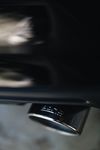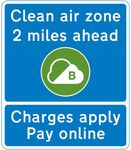Birmingham's Clean Air Zone - Halesowen Engine Remapping
←
→
Page content transcription
If your browser does not render page correctly, please read the page content below
Birmingham’s Clean Air Zone
Photo by Brian Lewicki
Birmingham City’s Clean Air Zone 2021
Back in August 2019, I wrote a short piece about
Birmingham’s Clean-Air Zone (CAZ), which was
due to come into force in July 2020. For a num-
ber of reasons, not least the impact of the Pan-
demic, the implication of the clean Air Zone was
postponed. The new date for implementation
has now been set for 1st June 2021 so it seems like a good time to look again at what this all
means for the people who live and work in and around the city.
Photo by Giorgio Trovato
The primary reason for the Clean Air Zone is to reduce levels of
Oxides of Nitrogen in the air to 40mg/m3 (40 micro grams per
cubic metre) or less. These NOx pollutants are produced by
both petrol and diesel vehicles, but diesel engines produce
about ten times as much, which is why they have come under
such criticism lately. NOx is a particularly harmful pollutant
causing serious respiratory problems, impaired lung function,
headaches, poor appetite and even corrosion of teeth!
The Charges
Only older, more polluting vehicles will be charged to enter the Clean Air Zone. The
hope is that these charges will discourage people from bringing these vehicles
into the city and encouraging the change to newer, cleaner vehicles. The charge
will be: -
• £8 per day for cars, vans, taxis, etc.
• £50 per day for buses, coaches and Large Goods Vehicles.
There will be no charge for: -
• Diesel or diesel-hybrid cars which comply with Euro 6, (about 2016 onwards)
• Petrol or petrol-hybrid cars which comply with Euro 4, (about 2006 onwards)
• Fully electric or hydrogen fuel cell vehicles
• Commercial vehicles which comply with Euro VIWhere will the charges apply?
The zone includes
the area within
the Middleway
Ring Road A4540.
The ring road
itself is not
included.
Map © Crown
copyright and
database rights 2019
Ordnance Survey
100021326lea
Exempt vehicles
Certain limited exemptions will be available for people who live within the zone or travel to work
within the zone. Conditions and time limits apply to these exemptions. In certain circumstances,
financial assistance is available and further details can be found here on Brum Breaths website.
Certain specific vehicles are also exempt. Again, see the Brum Breaths website for further infor-
mation.
Check your vehicle
Check if your vehicle is exempt from charges by going to www.gov.uk/
Retrospective upgrade to Euro 6
It is possible to upgrade a non-compliant vehicle to meet Euro 6 diesel or Euro 4 Petrol emission
standards in accordance with the ‘Clean Vehicle Retrofit Accreditation Scheme’(CVRAS). However,
for cars, this will not be economically viable as it will be cheaper to replace a car with a compliant
model such as a used, Euro 4 petrol car. It will probably also be cheaper to replace Euro 4 or Euro
5 vans with compliant models rather than convert them to Euro 6. Retrospective upgrade might
be a viable option for some specialist vehicles with expensive conversions. More information can
be found on the CVRAS website.Implications for remapping your vehicle
A good quality remap will keep your vehicle within its legal emissions limits and within the re-
quirements for the Euro classification it was given when it was built and should not cause any is-
sues. However, we have seen some very poor quality remaps and several remaps which have
been written to extract the maximum power from an engine without any regard for its emissions
(or its reliability and longevity). As always, you should only get your vehicle remapped by a repu-
table tuning business who can provide remaps which maintain low emissions and preserve the
reliability of your engine. Regardless of the quality of the remap, removing any of the vehicle’s
emission control equipment will take your vehicle well outside its legal emission limits and will
render it illegal to drive on the road under Construction and Use Regulations 61a(3)1. For this rea-
son, we do not offer any of the following services for road going vehicles: -
• EGR deletion – Exhaust gas recirculation gives significant reduction of NOx emissions. EGR
deletion on Euro 5 or 6 vehicles will also result in premature failure of the DPF.
• DPF deletion – Since May 2018 stricter MOT regulations mean that no vehicle which was de-
signed to be fitted with a DPF will fail its emission test and fail the MOT.
• Adblue deletion – Adblue systems are very commonly used to enable diesel vehicles to
reach Euro 6 emission standards by further reducing NOx emissions. More info can be found
in our article on AGR and Adblue.
Conclusion
Clean Air Zones and Low Emission Zones are going to become more common and if you’re going
to be using a diesel car or van, then anything less than Euro 6 is going to become quite limiting.
Obtaining a Euro 4 petrol engine vehicle could be a low cost alternative to a pre- Euro 6 diesel en-
gine vehicle. Although petrol engines give poorer fuel economy than diesel, later direct injection
petrol engines such as VW’s TSI engines and Ford’s Ecoboost engines can give fuel economy ap-
proaching that of a diesel engine and usually comply with Euro 5 or 6. So if you’re planning on
changing your vehicle any time soon, you should be looking at getting a Euro 6 diesel engine or
Euro 4 petrol engine as a minimum. You may even consider a zero emission vehicle such as a fully
electric vehicle. However, this would be a decision which, at the moment, would need very care-
ful consideration indeed.
Jeremy Howell, February 2021 Find out about
Remapping your vehicle
https://www.halesowenengineremap.co.uk/blog/#clean-air-zone 2021You can also read






















































